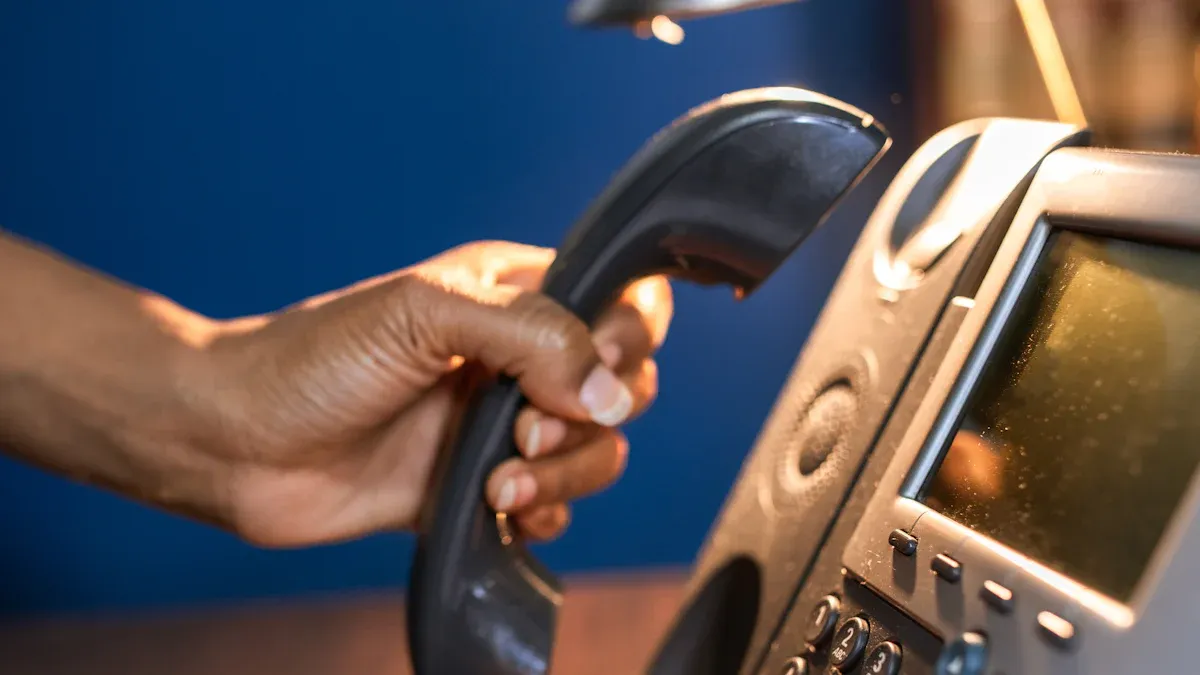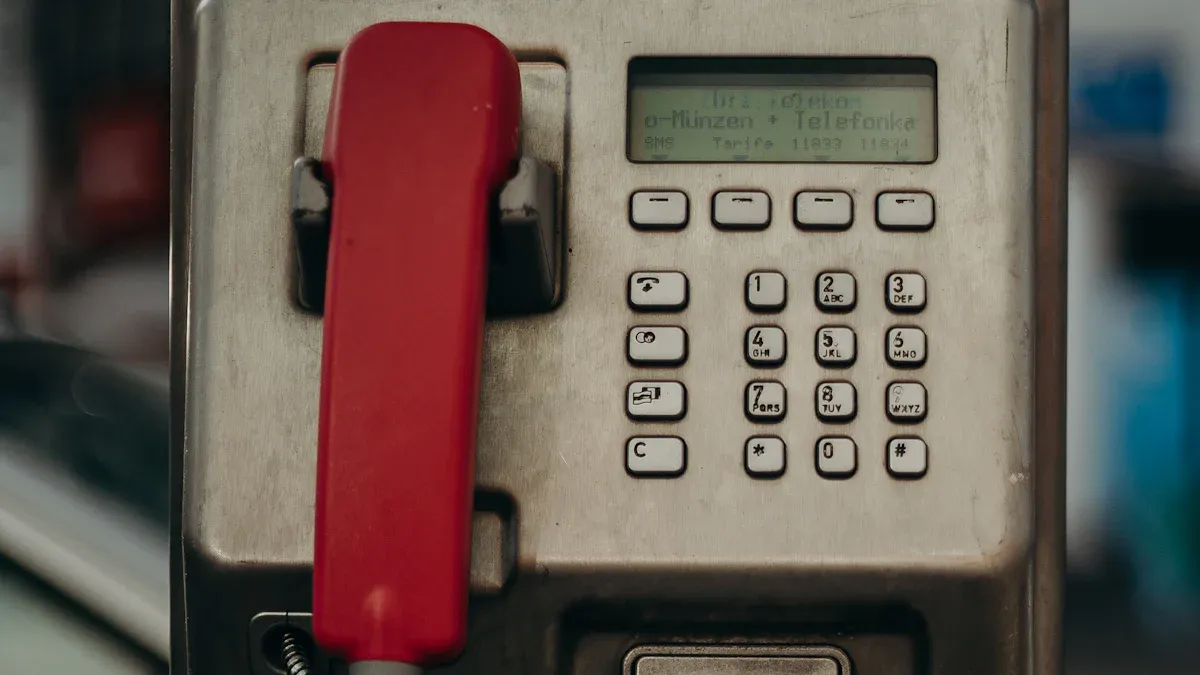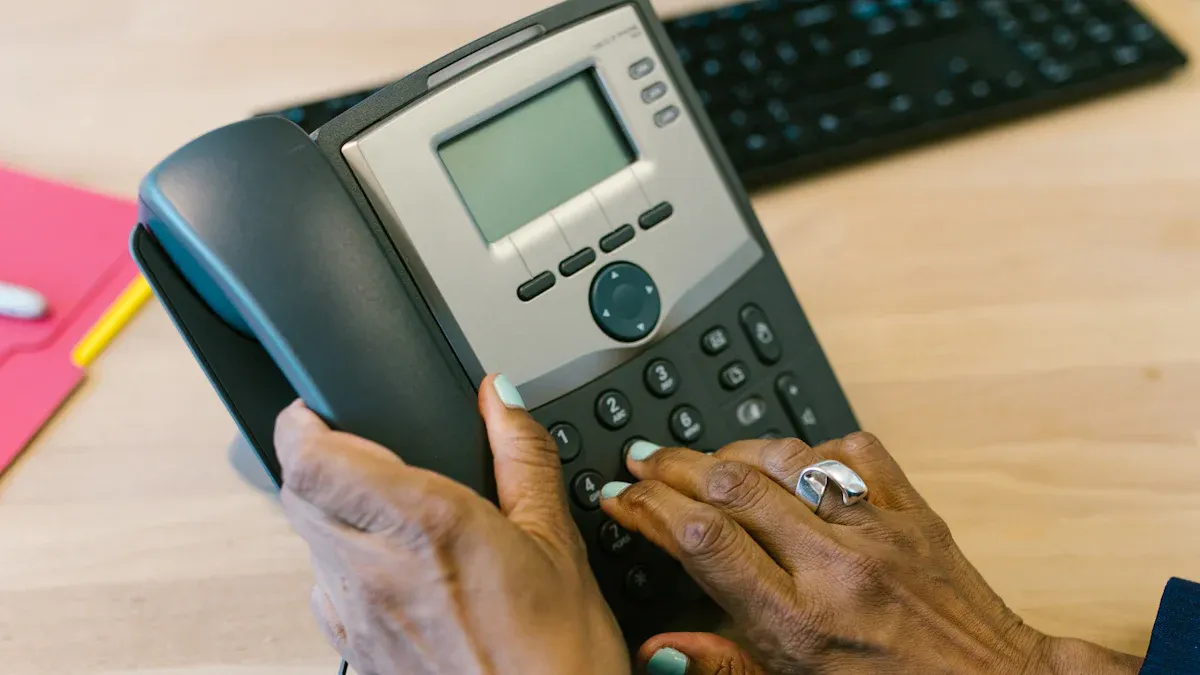
Maintaining weatherproof telephone handsets is crucial for their performance. Regular upkeep ensures these devices remain functional, especially in tough environments. It helps prevent damage and extends their lifespan. For those using an industrial telephone handset, this maintenance can make all the difference in reliability and efficiency.
Key Takeaways
- Regularly clean your weatherproof telephone handset to prevent dirt buildup. Use a soft, damp microfiber cloth with mild detergent for best results.
- Maintain your charger by avoiding overcharging and cleaning the charger port regularly. This ensures efficient charging and extends the life of both the charger and the handset.
- Create a maintenance schedule to keep your handset in top condition. Clean monthly, and adjust tasks seasonally to address specific environmental challenges.
Cleaning the Handset

Keeping your weatherproof telephone handset clean is essential for its performance and longevity. Regular cleaning helps prevent the buildup of dirt, grime, and contaminants that can affect functionality. Here are some tips to ensure you clean your handset effectively.
Recommended Cleaning Solutions
When it comes to cleaning solutions, it’s important to choose products that are safe for your handset. Here’s a quick reference table of recommended and unsafe cleaning solutions:
| Cleaning Tips | Safe Cleaning Solutions | Unsafe Cleaning Solutions |
|---|---|---|
| Turn off the phone before cleaning | Water-moistened cloth | Furniture polishes, waxes, or plasticizer-based cleaner |
| Never immerse in water | Mild detergent solution on a water-dampened cloth | Any product containing lanolin, aloe, glycerin, or other skin care ingredients |
| Do not spray cleaning solutions directly on the handset; use a cloth | Household glass and surface-type cleaner | Any solvent such as acetone, mineral spirits, etc. |
| Isopropyl alcohol on cloth (use occasionally) | ||
| Pre-moistened cloths for eyeglasses or cameras |
Using these safe solutions can help maintain the integrity of your handset while keeping it clean.
Safe Cleaning Techniques
When cleaning your handset, follow these techniques to ensure safety and effectiveness:
- Use a soft cloth: A microfiber cloth works best. It won’t scratch the surface and will effectively lift dirt.
- Dampen the cloth: Lightly moisten the cloth with your chosen cleaning solution. Avoid soaking it, as excess moisture can seep into the device.
- Wipe gently: Use gentle, circular motions to clean the surface. This technique helps remove grime without damaging the protective coatings.
- Avoid harsh scrubbing: Abrasive cleaning can strip protective coatings and degrade waterproof seals. Stick to soft materials to keep your handset in top shape.
Products to Avoid
Certain products can do more harm than good. Here are some items to steer clear of:
- Harsh chemicals: Products like bleach, hydrogen peroxide, and vinegar can corrode materials and make plastics brittle over time.
- Abrasive cleaners: These can scratch the surface and damage the handset’s finish.
- High-alcohol content wipes: They may affect touch sensitivity and degrade the materials used in the handset.
By avoiding these products, you can protect your weatherproof telephone handset from unnecessary damage.
Cleaning your handset regularly is crucial. Studies show that devices not cleaned frequently can harbor higher levels of microorganisms. So, make it a habit to clean your handset often to keep it safe and functional.
Maintaining the Charger

Maintaining the charger of your weatherproof telephone handset is just as important as caring for the handset itself. A well-maintained charger ensures that your device stays powered and ready for use. Here are some essential tips for keeping your charger in top shape.
Cleaning the Charger Port
A clean charger port helps prevent connectivity issues and ensures efficient charging. Here’s how to clean it effectively:
- Use Short Bursts: Apply short bursts of compressed air into the charging port. Aim at different angles to dislodge any dust or debris.
- Inspect for Residue: After using the air, check the port for any remaining particles. If you see more dust, repeat the process.
- Using Isopropyl Alcohol for Deeper Cleaning: Power off your device first. If needed, dilute isopropyl alcohol, apply it to a cotton swab, and gently clean the port. Inspect it afterward to ensure it’s clean.
- Safely Addressing Corrosion Issues: Look for signs of corrosion. Prepare a cleaning solution, apply it to the corroded areas, and wipe with isopropyl alcohol. Always inspect afterward.
- DIY Rescue for Water-Damaged Ports: If water gets into the port, act quickly. Remove excess water, dismantle the device if possible, and use desiccants to absorb moisture. Monitor the device before powering it on again.
Safe Charging Practices
Charging your handset correctly can significantly extend the life of both the charger and the device. Here are some practices to follow:
- Avoid Overcharging: Leaving your device plugged in after it’s fully charged can stress the circuitry. This can reduce the lifespan of your charger and cause damage.
- Watch Out for Extreme Temperatures: Charging in extreme heat or cold can degrade the charger’s components. Always charge in a moderate environment.
- Keep It Clean: Dust and debris can accumulate inside the charger. This buildup can obstruct airflow, leading to overheating and malfunctions. Regularly check and clean the charger to prevent this.
Signs of Charger Wear
Recognizing the signs of charger wear can help you address issues before they become serious. Here are some indicators to watch for:
- Frayed Cables: If you notice any fraying or exposed wires, it’s time to replace the charger. Using a damaged charger can be dangerous.
- Loose Connections: If the charger doesn’t fit snugly in the port, it may be wearing out. A loose connection can lead to inconsistent charging.
- Overheating: If the charger gets excessively hot during use, it may indicate a problem. Stop using it immediately and consider replacing it.
By following these maintenance tips, you can ensure that your charger remains functional and reliable. This attention to detail will help keep your industrial telephone handset ready for action, no matter the conditions.
Caring for the Headset Connector
Caring for the headset connector is vital for maintaining the performance of weatherproof telephone handsets. A clean and functional connector ensures clear communication, especially in challenging environments. Here are some tips to keep your headset connector in top shape.
Cleaning Methods for the Connector
To clean the headset connector effectively, follow these steps:
- Use isopropyl alcohol on a non-padded cotton swab.
- Gently twist the swab inside the connector and repeat several times.
- Optionally, use compressed air to blow out any debris.
These methods help remove dirt and grime that can interfere with connectivity.
Preventing Moisture Damage
Moisture can wreak havoc on headset connectors, leading to electrical failures and corrosion. To protect your device, consider these strategies:
| Strategy | Description |
|---|---|
| Sealing Enclosures | Protects sensitive electronics by housing them in enclosed containers to block external moisture. |
| Waterproof Connectors | Provides a reliable, sealed connection that resists moisture ingress in electrical systems. |
| Desiccant Packaging | Absorbs moisture within enclosures to maintain a dry environment for sensitive components. |
| Insulation Materials | Uses high-grade materials to prevent moisture ingress in wires and connectors, especially outdoors. |
Implementing these strategies can significantly enhance the durability of your industrial telephone handset.
When to Replace the Connector
Knowing when to replace the headset connector is crucial. If you notice any of the following signs, it’s time for a replacement:
- Corrosion: Visible rust or discoloration indicates moisture damage.
- Loose Fit: If the connector doesn’t fit snugly, it may no longer provide a reliable connection.
- Intermittent Sound: If audio cuts in and out, the connector might be failing.
Addressing these issues promptly can prevent further damage and ensure your handset remains functional.
Regular Maintenance Schedule
Creating a regular maintenance schedule is key to keeping weatherproof telephone handsets in top condition. By establishing a routine, users can ensure their devices remain functional and reliable.
Frequency of Cleaning
Cleaning your handset should happen regularly. A good rule of thumb is to clean it at least once a month. However, if the handset is used in particularly dusty or dirty environments, consider cleaning it weekly. Regular cleaning prevents dirt buildup and keeps the device functioning optimally.
Seasonal Maintenance Tips
Seasonal changes can impact maintenance needs. Here’s a quick look at what to focus on each season:
| Season | Maintenance Focus |
|---|---|
| Summer | Regular upkeep and cleaning of outdoor cabinets, power systems, and TE equipment; temperature control is vital. |
| Fall | Checking landscaping, raking leaves, clearing debris, and performing weatherproofing checks. |
| Winter | Preventing equipment from freezing, ensuring uptime during extreme weather, and checking humidifiers. |
| Spring | Ensuring power source efficiency, testing backup systems, and preventing water damage. |
By adjusting maintenance tasks according to the season, users can enhance the longevity of their industrial telephone handsets.
Keeping a Maintenance Log
Maintaining a detailed log of all maintenance activities offers several benefits. Here’s why keeping a log is essential:
| Benefit | Description |
|---|---|
| Improved Efficiency | Digital logs provide real-time access to maintenance history, allowing for quicker decision-making. |
| Proactive Maintenance | Enables planning for upcoming service needs, reducing unexpected breakdowns. |
| Better Tracking of Service Needs | Comprehensive records help prioritize maintenance tasks and ensure timely service. |
A maintenance log not only helps track what has been done but also aids in planning future maintenance tasks effectively.
Additional Tips for Industrial Telephone Handsets
Maintaining industrial telephone handsets goes beyond regular cleaning and charging. Proper handling and storage practices play a significant role in ensuring these devices last longer and perform well. Here are some best practices to consider:
Handling and Storage Best Practices
To protect your industrial telephone handset from damage, follow these handling and storage tips:
- Use water- or weatherproof cases to minimize exposure to the elements.
- Select materials like polycarbonate to prevent UV damage and water penetration.
- Consider resealable, waterproof bags for extra protection during outdoor activities.
Whenever possible, use the original packaging for optimal protection. Wrap devices individually in anti-static bubble wrap to prevent static discharge. Finally, place wrapped electronics in cushioned boxes, filling empty spaces with foam or packing peanuts.
Checking for Wear and Damage
Regularly checking for wear and damage is crucial. Look for signs like frayed cables, loose connections, or corrosion. Addressing these issues promptly can prevent further damage. A quick visual inspection every month can save you from bigger problems down the line.
Ensuring Secure Connections
Secure connections are vital for the functionality of industrial telephone handsets. Here are some tips to ensure they remain intact:
| Installation Tips | Maintenance Best Practices |
|---|---|
| Mount phones at visible and accessible heights. | Inspect casing and seals quarterly. |
| Use IP-rated cable seals to prevent moisture ingress. | Check microphone and speaker functionality monthly. |
| Position near workstations or critical equipment. | Clean external surfaces to remove dirt and corrosive deposits. |
| Include backup power supply where needed. | Test connectivity to control rooms or external lines. |
| Train workers in emergency use procedures. | Update firmware for VoIP models as required. |
By following these tips, users can enhance the reliability and longevity of their industrial telephone handsets.
In summary, keeping weatherproof telephone handsets in great shape requires regular cleaning, proper charging, and careful handling. 🧼🔌 By following these maintenance tips, users can ensure their devices last longer and perform better. Remember, consistent upkeep is key to maximizing the lifespan of your handset. So, make maintenance a habit!
FAQ
What is the best way to clean a weatherproof telephone handset?
Use a soft, damp microfiber cloth with mild detergent. Avoid harsh chemicals and abrasive materials to protect the handset’s surface.
How often should I perform maintenance on my handset?
Aim for monthly cleaning and inspections. Increase frequency in dusty or harsh environments to ensure optimal performance.
What should I do if my charger shows signs of wear?
Replace the charger immediately if you notice frayed cables, loose connections, or overheating. Using a damaged charger can be dangerous.

